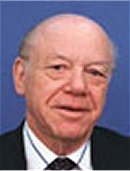|
|
Plenary
Lecture
A Rational Integrated Approach to Designer Materials, Aerodynamics, Structural Control and Vehicle Performance: Analytical and Computational Issues

Professor Harry H. Hilton
University of Illinois at Urbana-Champaign
Department of Aerospace Engineering
National Center for Supercomputing Applications
104 South Wright Street, Urbana, IL 61801-2935
United States of America
E-mail:
h-hilton@illinois.edu
Abstract: Traditional protocols as well as past and
current conventional wisdom dictate that structural
members be analyzed and designed based on readily
available “off the shelf” materials. Similarly,
aerodynamic shapes are selected from catalogued airfoils
and performance is placed on a “best can do” rational.
Prescribed limitations, such as constraints on cost,
weight, some dimensions, service performances, etc.,
then leave open only one or two dimensional adjustments
for each structural member in order to attempt to
satisfy the desired operational effects.
On the other hand, the Computational Structural/Solid
Mechanics Group at NCSA/TRECC has developed a novel
general analytical approach that is based on the
calculus of variations, where material properties,
morphed airfoil shapes and servo-controls are
tailored/engineered to produce prescribed structural,
aerodynamic, aeroelastic and aero-viscoelastic effects
as well as flight performance. In essence, this replaces
the present prevailing reliance on geometric sizing and
supersedes it with optimal material and aerodynamic
behavior for each structural element and aerodynamic
shape.. Effectively, one does not set out to build a
better mouse trap mechanism, but rather analytically
determine optimal properties, which if manufactured will
produce the “best” mouse trap.
The fundamental paradigm for flight and submarine
light-weight structures is the pervasive requirements
for analyses and designs that yield high-strength yet
lightweight material construction and high lift/low drag
devices with integrated with fluid/solid interactions.
To that end, proper materials, analytical and
computational tools and novel cost effective approaches
must be initiated and utilized. Composites have found
wide acceptance in fulfilling a significant number of
these requirements and are being used to replace many
traditional metal (aluminum, magnesium, titanium, etc.)
structural components. However, they generally do not
behave elastically but rather viscoelastically thus
bringing into focus the additional time dimension;
relaxation and creep properties and degradation of
moduli and failure stresses with time. Ultimately,
viscoelasticity introduces new phenomena, such as
damping, creep and time dependent failure concepts
leading to structural lifetime or survival time criteria
as well as deformation induced alterations in
aerodynamic responses.
The ultimate benefits stemming from analyses based on
designer materials, aerodynamics and controls are that
more efficient overall optimal systems can be realized
in terms of overall material properties, sizing,
performance, response to loads and temperatures, etc.
Of course, the as yet unexamined additionally needed new
procedures for manufacturing structural materials to
prescribed specifications based on their a priory
mechanical properties require to be addressed separately
by material scientists. If nothing else, at least new
data bases of needed material properties can be
established through computer simulations of the
analytical results which will serve as guides to
materials manufacturers as to what properties are
desirable and needed. A parallel statement can be made
for new airfoil geometries.
Brief Biography of the Speaker:
BS 47 and MS 49 Aeronautical Eng. (compressible
aerodynamics) New York U., Ph. D. Theoretical & Applied
Mechanics (solid mechanics major with mathematics minor)
51 U of IL. At UIUC since 1949. Aeronautical &
Astronautical Eng. department head 74 - 85, assistant
dean of engineering sum-mers 1989 & 90. Charles E.
Schmidt Distinguished Visiting Professor, Florida
Atlantic U., 1997 – 2001, 2007. Fellow of the American
Institute of Aeronautics and Astronautics (AIAA).
External examiner Nanyang Technological University,
Singapore.
Current member of the AIAA Structures Technical
Committee, AIAA Advisory Committee on Web Development,
AIAA Non-Deterministic Applications Technical Committee,
ASME Random Structural Problems Committee, the ASTM
Committee D-30 on Composite Materials and two scientific
committees organizing international conferences. He is
also chairs the AIAA Illinois Section and is a regional
director for Sigma Gamma Tau, the national aerospace
engineering honor society.
After his retirement in 1990, he has continued to be
actively engaged in research, teaching, MS & PhD thesis
advising and in public and professional service. He has
published or had accepted for publication over 300
papers in archival journals or conference proceedings.
His current active analytical & computational research
areas are deterministic and stochastic linear and
nonlinear viscoelasticity, composites, aeroviscoelasti
city, aerodynamic noise, computational solid me¬chanics,
structural control and probabilistic failure criteria
and analysis, damping & nonlinear dynamics, linear &
nonlinear anisotropic viscoelastic finite element
analysis, optimum designer materials, piezoelectric,
magnetic, and functionally graded viscoelastic
materials, electronic packaging, nonlinear creep and
delamination column & plate buckling, analytical
determination of damping properties, material
characterization, stochastic minimum structural weight
analysis, probabilistic delamination of composites
during service and manufacturing processes (cure),
structural control and survivability, engineering
education, and structural integrity of dentures.
|
|
